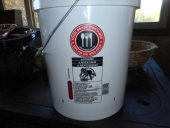New to long-term food preservation. As I understand:
1: Only certain foods can be stored using oxygen absorbers, generally, powdery foods are out, and "moist" and "oily" foods are out.
2: Moisture content of the food must be at/below 10% (higher and bochulism is an issue, too low and the oxygen absorbers can't work since they operate via iron/rust reaction which needs H20)
3: Silica packets do dehydrate food, but uncontrollably. Therefore, they cannot be used in combination with oxygen absorbers.
My question is:
How do I safely create a consistent moisture content in the foods stored, so that I can have assurance that they are within the acceptable range for oxygen absorbers?
Bonus question: How do I inspect food stuffs before consumption to ensure they are safe to eat? (aside from the obvious broken seals) For example, smells to check for, or purchasing more "pink dot" stickers that come with absorbers so that one can be added to each container...?
Money question: Does anyone have a cheat sheet of foods and storage methods/amounts including oxygen absorbers, silica gel packs, diatomaceous earth, etc?
Best information sources I've found so far:
https://www.thesurvivalistblog.net/oxygen-absorbers/#How_Are_Oxygen_Absorbers_and_Silica_Gel_Differenthttps://www.churchofjesuschrist.org/topics/food-storage/longer-term-food-supply?lang=eng#1https://www.youtube.com/watch?v=P5nkbB_UsP0https://www.youtube.com/watch?v=dn0uESzlOvoBased on this paper there is no good way for developing countries to accurately measure/control moisture content. https://www.sciencedirect.com/science/article/pii/S0924224418304898






